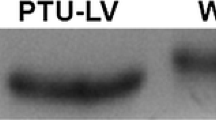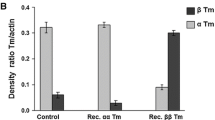Abstract
Cross-bridge kinetics were studied at 20 °C in cardiac muscle strips from transgenic (Tg) mice expressing N-terminal 43 amino acid truncation mutation (Δ43) of myosin essential light chain (ELC), and the results were compared to those from Tg-wild type (WT) mice. Sinusoidal length changes were applied to activated skinned papillary muscle strips to induce tension transients, from which two exponential processes were deduced to characterize the cross-bridge kinetics. Their two rate constants were studied as functions of ATP, phosphate (Pi), ADP, and Ca2+ concentrations to characterize elementary steps of the cross-bridge cycle consisting of six states. Our results demonstrate for the first time that the cross-bridge kinetics of Δ43 are accelerated owing to an acceleration of the rate constant k 2 of the cross-bridge detachment step, and that the number of strongly attached cross-bridges are decreased because of a reduction of the equilibrium constant K 4 of the force generation step. The isometric tension and stiffness of Δ43 are diminished compared to WT, but the force per cross-bridge is not changed. Stiffness measurement during rigor induction demonstrates a reduction in the stiffness in Δ43, indicating that the N-terminal extension of ELC forms an extra linkage between the myosin cross-bridge and actin. The tension-pCa study demonstrates that there is no Ca2+ sensitivity change with Δ43, but the cooperativity is diminished. These results demonstrate the importance of the N-terminal extension of ELC in maintaining the myosin motor function during force generation and optimal cardiac performance.









Similar content being viewed by others
References
Aydt EM, Wolff G, Morano I (2007) Molecular modeling of the myosin-S1(A1) isoform. J Struct Biol 159(1):158–163
Bottinelli R, Betto R, Schiaffino S, Reggiani C (1994) Unloaded shortening velocity and myosin heavy chain and alkali light chain isoform composition in rat skeletal muscle fibres. J Physiol 478(Pt 2):341–349
Buckingham M, Kelly R, Tajbakhsh S, Zammit P (1998) The formation and maturation of skeletal muscle in the mouse: the myosin MLC1F/3F gene as a molecular model. Acta Physiol Scand 163(3):S3–S5
Dantzig JA, Goldman YE, Millar NC, Lacktis J, Homsher E (1992) Reversal of the cross-bridge force-generating transition by photogeneration of phosphate in rabbit psoas muscle fibres. J Physiol 451:247–278
Fortune NS, Geeves MA, Ranatunga KW (1991) Tension responses to rapid pressure release in glycerinated rabbit muscle fibers. Proc Natl Acad Sci USA 88(16):7323–7327
Frank G, Weeds AG (1974) The amino-acid sequence of the alkali light chains of rabbit skeletal-muscle myosin. Eur J Biochem 44(2):317–334
Godt RE, Maughan DW (1988) On the composition of the cytosol of relaxed skeletal muscle of the frog. Am J Physiol 254(5 Pt 1):C591–C604
Gordon AM, Homsher E, Regnier M (2000) Regulation of contraction in striated muscle. Physiol Rev 80(2):853–924
Henry GD, Winstanley MA, Dalgarno DC, Scott GM, Levine BA, Trayer IP (1985) Characterization of the actin-binding site on the alkali light chain of myosin. Biochim Biophys Acta 830(3):233–243
Hernandez OM, Jones M, Guzman G, Szczesna-Cordary D (2007) Myosin essential light chain in health and disease. Am J Physiol Heart Circ Physiol 292(4):H1643–H1654
Houdusse A, Cohen C (1996) Structure of the regulatory domain of scallop myosin at 2 A resolution: implications for regulation. Structure 4(1):21–32
Iwamoto H (2000) Influence of ionic strength on the actomyosin reaction steps in contracting skeletal muscle fibers. Biophys J 78(6):3138–3149. doi:10.1016/S0006-3495(00)76850-0
Julian FJ, Moss RL (1981) Effects of calcium and ionic strength on shortening velocity and tension development in frog skinned muscle fibres. J Physiol 311:179–199
Kawai M (1978) Head rotation or dissociation? A study of exponential rate processes in chemically skinned rabbit muscle fibers when MgATP concentration is changed. Biophys J 22(1):97–103. doi:10.1016/S0006-3495(78)85473-3
Kawai M, Brandt PW (1980) Sinusoidal analysis: a high resolution method for correlating biochemical reactions with physiological processes in activated skeletal muscles of rabbit, frog and crayfish. J Muscle Res Cell Motil 1(3):279–303
Kawai M, Halvorson HR (1989) Role of MgATP and MgADP in the cross-bridge kinetics in chemically skinned rabbit psoas fibers. Study of a fast exponential process (C). Biophys J 55(4):595–603
Kawai M, Halvorson HR (1991) Two step mechanism of phosphate release and the mechanism of force generation in chemically skinned fibers of rabbit psoas muscle. Biophys J 59(2):329–342
Kawai M, Kuntz ID (1973) Optical diffraction studies of muscle fibers. Biophys J 13:857–876
Kawai M, Zhao Y (1993) Cross-bridge scheme and force per cross-bridge state in skinned rabbit psoas muscle fibers. Biophys J 65(2):638–651. doi:10.1016/S0006-3495(93)81109-3
Kawai M, Cox RN, Brandt PW (1981) Effect of Ca ion concentration on cross-bridge kinetics in rabbit psoas fibers. Evidence for the presence of two Ca-activated states of thin filament. Biophys J 35(2):375–384. doi:10.1016/S0006-3495(81)84796-0
Kawai M, Wray JS, Guth K (1990) Effect of ionic strength on crossbridge kinetics as studied by sinusoidal analysis, ATP hydrolysis rate and X-ray diffraction techniques in chemically skinned rabbit psoas fibres. J Muscle Res Cell Motil 11(5):392–402
Kawai M, Saeki Y, Zhao Y (1993) Crossbridge scheme and the kinetic constants of elementary steps deduced from chemically skinned papillary and trabecular muscles of the ferret. Circ Res 73(1):35–50
Kazmierczak K, Xu Y, Jones M, Guzman G, Hernandez OM, Kerrick WG, Szczesna-Cordary D (2009) The role of the N-terminus of the myosin essential light chain in cardiac muscle contraction. J Mol Biol 387(3):706–725
Kuby SA, Noda L, Lardy HA (1954) Adenosinetriphosphate-creatine transphosphorylase. I. Isolation of the crystalline enzyme from rabbit muscle. J Biol Chem 209(1):191–201
Lawson JW, Veech RL (1979) Effects of pH and free Mg2+ on the Keq of the creatine kinase reaction and other phosphate hydrolyses and phosphate transfer reactions. J Biol Chem 254(14):6528–6537
Lowey S, Trybus KM (2010) Common structural motifs for the regulation of divergent class II myosins. J Biol Chem 285(22):16403–16407. doi:10.1074/jbc.R109.025551
Lowey S, Waller GS, Trybus KM (1993) Skeletal muscle myosin light chains are essential for physiological speeds of shortening. Nature 365(6445):454–456
Lowey S, Saraswat LD, Liu H, Volkmann N, Hanein D (2007) Evidence for an interaction between the SH3 domain and the N-terminal extension of the essential light chain in class II myosins. J Mol Biol 371(4):902–913
Michael JJ, Gollapudi SK, Ford SJ, Kazmierczak K, Szczesna-Cordary D, Chandra M (2012) Deletion of 1–43 amino acids in cardiac myosin essential light chain blunts length dependency of Ca2+ sensitivity and crossbridge detachment kinetics. Am J Physiol Heart Circ Physiol. doi:10.1152/ajpheart.00572.2012
Miller MS, Palmer BM, Ruch S, Martin LA, Farman GP, Wang Y, Robbins J, Irving TC, Maughan DW (2005) The essential light chain N-terminal extension alters force and fiber kinetics in mouse cardiac muscle. J Biol Chem 280(41):34427–34434
Milligan RA, Whittaker M, Safer D (1990) Molecular structure of F-actin and location of surface binding sites. Nature 348(6298):217–221
Miyanishi T, Ishikawa T, Hayashibara T, Maita T, Wakabayashi T (2002) The two actin-binding regions on the myosin heads of cardiac muscle. Biochemistry 41(17):5429–5438
Morano I (1999a) Tuning the human heart molecular motors by myosin light chains. J Mol Med (Berl) 77(7):544–555
Morano I (1999b) Tuning the human heart molecular motors by myosin light chains. J Mol Med 77(7):544–555
Morano I, Ritter O, Bonz A, Timek T, Vahl CF, Michel G (1995) Myosin light chain-actin interaction regulates cardiac contractility. Circ Res 76(5):720–725
Muthu P, Wang L, Yuan CC, Kazmierczak K, Huang W, Hernandez OM, Kawai M, Irving TC, Szczesna-Cordary D (2011) Structural and functional aspects of the myosin essential light chain in cardiac muscle contraction. FASEB J 25(12):4394–4405
Opie LH, Mansford KR, Owen P (1971) Effects of increased heart work on glycolysis and adenine nucleotides in the perfused heart of normal and diabetic rats. Biochem J 124(3):475–490
Rayment I, Rypniewski WR, Schmidt-Base K, Smith R, Tomchick DR, Benning MM, Winkelmann DA, Wesenberg G, Holden HM (1993) Three-dimensional structure of myosin subfragment-1: a molecular motor. Science 261(5117):50–58
Ritter O, Luther HP, Haase H, Baltas LG, Baumann G, Schulte HD, Morano I (1999) Expression of atrial myosin light chains but not alpha-myosin heavy chains is correlated in vivo with increased ventricular function in patients with hypertrophic obstructive cardiomyopathy. J Mol Med 77(9):677–685
Roth K, Hubesch B, Meyerhoff DJ, Naruse S, Gober JR, Lawry TJ, Boska MD, Matson GB, Weiner MW (1989) Noninvasive quantitation of phosphorus metabolites in human tissue by NMR spectroscopy. J Magn Res 81:299–311
Sutoh K (1982) An actin-binding site on the 20 K fragment of myosin subfragment 1. Biochemistry 21(19):4800–4804
Sweeney HL (1995) Function of the N terminus of the myosin essential light chain of vertebrate striated muscle. Biophys J 68(4 Suppl):112S–118S discussion 118S-119S
Szczesna D (2003) Regulatory light chains of striated muscle myosin. Structure, function and malfunction. Curr Drug Targets Cardiovasc Haematol Disord 3(2):187–197
Teague WE Jr, Dobson GP (1992) Effect of temperature on the creatine kinase equilibrium. J Biol Chem 267(20):14084–14093
Timson DJ (2003) Fine tuning the myosin motor: the role of the essential light chain in striated muscle myosin. Biochimie 85(7):639–645
Timson DJ, Trayer HR, Trayer IP (1998) The N-terminus of A1-type myosin essential light chains binds actin and modulates myosin motor function. Eur J Biochem 255(3):654–662
Timson DJ, Trayer HR, Smith KJ, Trayer IP (1999) Size and charge requirements for kinetic modulation and actin binding by alkali 1-type myosin essential light chains. J Biol Chem 274(26):18271–18277
Ushakov DS (2008) Structure and function of the essential light chain of myosin. Biofizika 53(6):950–955
Wannenburg T, Heijne GH, Geerdink JH, Van-Den-Dool HW, Janssen PM, DeTombe PP (2000) Cross-bridge kinetics in rat myocardium: effect of sarcomere length and calcium activation. Am J Physiol Heart Circ Physiol 279:H779–H790
Weeds AG, Lowey S (1971) Substructure of the myosin molecule II. The light chains of myosin. J Mol Biol 61(3):701–725
Winstanley MA, Trayer HR, Trayer IP (1977) Role of the myosin light chains in binding to actin. FEBS Lett 77(2):239–242
Zhao Y, Kawai M (1994) Kinetic and thermodynamic studies of the cross-bridge cycle in rabbit psoas muscle fibers. Biophys J 67(4):1655–1668
Acknowledgments
We thank Ana I. Rojas and Jingsheng Liang (University of Miami) for their excellent technical assistance with transgenic mice and cardiac muscle. This work was supported in part by grants from the National Institutes of Health HL070041 (M.K.); HL108343, HL071778 and HL090786 (D.S–C.); and the American Heart Association 10POST3420009 (P.M.). The content is solely the responsibility of the authors and does not necessarily reflect the official views of the National Center for Research Resources or the NIH.
Author information
Authors and Affiliations
Corresponding author
Rights and permissions
About this article
Cite this article
Wang, L., Muthu, P., Szczesna-Cordary, D. et al. Characterizations of myosin essential light chain’s N-terminal truncation mutant Δ43 in transgenic mouse papillary muscles by using tension transients in response to sinusoidal length alterations. J Muscle Res Cell Motil 34, 93–105 (2013). https://doi.org/10.1007/s10974-013-9337-x
Received:
Accepted:
Published:
Issue Date:
DOI: https://doi.org/10.1007/s10974-013-9337-x




